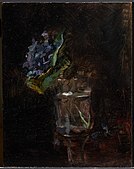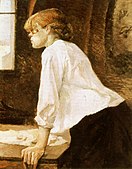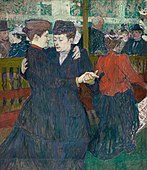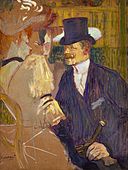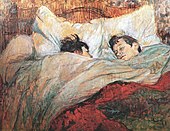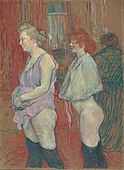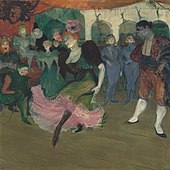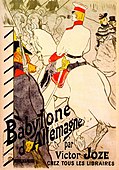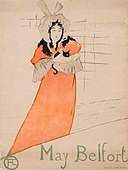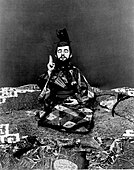Comte Henri Marie Raymond de Toulouse-Lautrec-Monfa (24 November 1864 – 9 September 1901), known as Toulouse-Lautrec (French: [tuluz lotʁɛk]), was a French painter, printmaker, draughtsman, caricaturist, and illustrator whose immersion in the colourful and theatrical life of Paris in the late 19th century allowed him to produce a collection of enticing, elegant, and provocative images of the sometimes decadent affairs of those times.
Henri de Toulouse-Lautrec | |
|---|---|
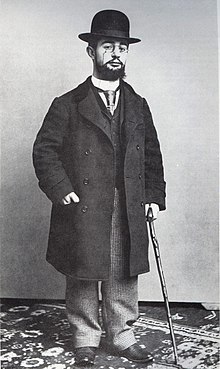 Toulouse-Lautrec in 1894 | |
| Born | Henry Marie Raymond de Toulouse-Lautrec-Monfa 24 November 1864 Albi, Tarn, Second French Empire |
| Died | 9 September 1901 (aged 36) |
| Resting place | Cimetière de Verdelais |
| Known for | Painting, printmaking, drawing, draughting, illustration |
| Notable work | At the Moulin Rouge Le Lit La Toilette |
| Movement | Post-Impressionism, Art Nouveau |
| Signature | |
 | |
Born into the aristocracy, Toulouse-Lautrec broke both his legs around the time of his adolescence and, possibly due to the rare condition pycnodysostosis, was very short as an adult due to his undersized legs. In addition to alcoholism, he developed an affinity for brothels and prostitutes that directed the subject matter for many of his works, which record details of the late-19th-century bohemian lifestyle in Paris. He is among the painters described as being Post-Impressionists, with Paul Cézanne, Vincent van Gogh, Paul Gauguin, and Georges Seurat also commonly considered as belonging in this loose group.
In a 2005 auction at Christie's auction house, La Blanchisseuse, Toulouse-Lautrec's early painting of a young laundress, sold for US$22.4 million, setting a new record for the artist for a price at auction.[1]
Early life
Henri[2] Marie Raymond de Toulouse-Lautrec Monfa was born at the Château du Bosc, Camjac, Aveyron, in the south of France, the firstborn child of Count Alphonse de Toulouse-Lautrec Montfa (1838–1913)[3] and Adèle Zoë Tapié de Celeyran (1841–1930).[4] He was a member of an aristocratic family (descended from both the Counts of Toulouse and Odet de Foix, Vicomte de Lautrec, as well as the Viscounts of Montfa). His younger brother was born in 1867 but died the following year. Both sons enjoyed the titres de courtoisie of Comte.[5] If Henri had outlived his father, he would have been accorded the family title of Comte de Toulouse-Lautrec.[6]
After the death of his brother, Toulouse-Lautrec's parents separated and a nanny cared for him.[7] At the age of eight, Toulouse-Lautrec lived with his mother in Paris, where he drew sketches and caricatures in his exercise workbooks. A friend of his father, René Princeteau, sometimes visited to give informal lessons. Some of Toulouse-Lautrec's early paintings are of horses, a speciality of Princeteau's and a subject Toulouse-Lautrec later revisited in his "Circus Paintings".[7][8]
In 1875, Toulouse-Lautrec returned to Albi because his mother had concerns about his health. He took thermal baths at Amélie-les-Bains, and his mother consulted doctors in the hope of finding a way to improve her son's growth and development.[7]
Disability and health problems

Toulouse-Lautrec's parents were first cousins (their mothers were sisters),[9] and his congenital health conditions have often been attributed to a family history of inbreeding.[10]
At the age of 13, Toulouse-Lautrec fractured his right femur, and at age 14, he fractured his left femur.[11] The breaks did not heal properly. Modern physicians attribute this to an unknown genetic disorder, possibly pycnodysostosis (sometimes known as Toulouse-Lautrec Syndrome),[12][13] or a variant disorder along the lines of osteopetrosis, achondroplasia, or osteogenesis imperfecta.[14] Toulouse-Lautrec's legs ceased to grow when he reached 1.52 m or 5 ft 0 in.[15] He developed an adult torso while retaining his child-sized legs.[16]
Paris

During a stay in Nice, France, his progress in painting and drawing impressed Princeteau, who persuaded Toulouse-Lautrec's parents to allow him to return to Paris and study under the portrait painter Léon Bonnat. He returned to Paris in 1882.[18] Toulouse-Lautrec's mother had high ambitions and, with the aim of her son becoming a fashionable and respected painter, used their family's influence to gain him entry to Bonnat's studio.[7] He was drawn to Montmartre, the area of Paris known for its bohemian lifestyle and the haunt of artists, writers, and philosophers. Studying with Bonnat placed Toulouse-Lautrec in the heart of Montmartre, an area he rarely left over the next 20 years.
After Bonnat took a new job, Toulouse-Lautrec moved to the studio of Fernand Cormon in 1882 and studied for a further five years and established the group of friends he kept for the rest of his life. At this time, he met Émile Bernard and Vincent van Gogh. Cormon, whose instruction was more relaxed than Bonnat's, allowed his pupils to roam Paris, looking for subjects to paint. During this period, Toulouse-Lautrec had his first encounter with a prostitute (reputedly sponsored by his friends), which led him to paint his first painting of a prostitute in Montmartre, a woman rumoured to be Marie-Charlet.[7]

Early career
In 1885, Toulouse-Lautrec began to exhibit his work at the cabaret of Aristide Bruant's Mirliton.[19]
With his studies finished, Toulouse-Lautrec participated in an exposition in 1887 in Toulouse using the pseudonym "Tréclau", the verlan of the family name "Lautrec". He later exhibited in Paris with Van Gogh and Louis Anquetin.[7]
In 1885, Toulouse-Lautrec met Suzanne Valadon. He made several portraits of her and supported her ambition as an artist. It is believed that they were lovers and that she wanted to marry him. Their relationship ended, and Valadon attempted suicide in 1888.[20]
Rise to recognition
In 1888, the Belgian critic Octave Maus invited Lautrec to present eleven pieces at the Vingt (the 'Twenties') exhibition in Brussels in February. Theo van Gogh, the artist's brother, bought Poudre de Riz (Rice Powder) for 150 francs for the Goupil & Cie gallery.
From 1889 to 1894, Toulouse-Lautrec took part in the Salon des Indépendants regularly. He made several landscapes of Montmartre.[7] Tucked deep into Montmartre in Monsieur Pere Foret's garden, Toulouse-Lautrec executed a series of pleasant en plein air paintings of Carmen Gaudin, the same red-headed model who appears in The Laundress (1888).
In 1890, during the banquet of the XX exhibition in Brussels, he challenged to a duel the artist Henri de Groux, who criticised van Gogh's works. Paul Signac also declared he would continue to fight for Van Gogh's honour if Lautrec was killed. De Groux apologised for the slight and left the group, and the duel never took place.[21][22]
Toulouse-Lautrec contributed several illustrations to the magazine Le Rire during the mid-1890s.[23]
Interactions with women
In addition to his growing alcoholism, Toulouse-Lautrec also visited prostitutes.[24] He was fascinated by their lifestyle as well as that of the "urban underclass", and he incorporated those characters into his paintings.[25] Fellow painter Édouard Vuillard later said that while Toulouse-Lautrec did engage in sex with prostitutes, "the real reasons for his behaviour were moral ones ... Lautrec was too proud to submit to his lot, as a physical freak, an aristocrat cut off from his kind by his grotesque appearance. He found an affinity between his condition and the moral penury of the prostitute."[26]
The prostitutes inspired Toulouse-Lautrec. He would frequently visit a brothel located in Rue d'Amboise, where he had a favourite called Mireille.[27] He created about a hundred drawings and fifty paintings inspired by the life of these women. In 1892 and 1893, he created a series of two women in bed together called Le Lit, and in 1894 he painted Salón de la Rue des Moulins from memory in his studio.[27]
Toulouse-Lautrec declared, "A model is always a stuffed doll, but these women are alive. I wouldn't venture to pay them the hundred sous to sit for me, and god knows whether they would be worth it. They stretch out on the sofas like animals, make no demand and they are not in the least bit conceited." He was well appreciated by the women, saying, "I have found girls of my own size! Nowhere else do I feel so much at home."[27]
The Moulin Rouge
When the Moulin Rouge cabaret opened in 1889,[19] Toulouse-Lautrec was commissioned to produce a series of posters. His mother had left Paris and, though he had a regular income from his family, making posters offered him a living of his own. Other artists looked down on the work, but he ignored them.[28] The cabaret reserved a seat for him and displayed his paintings.[29] Among the works that he painted for the Moulin Rouge and other Parisian nightclubs are depictions of the singer Yvette Guilbert; the dancer Louise Weber, better known as La Goulue (The Glutton), who created the French can-can; and the much subtler dancer Jane Avril.
London

Toulouse-Lautrec's family were Anglophiles,[30] and though he was not as fluent as he pretended to be, he spoke English well enough.[28] He travelled to London, where he was commissioned by the J. & E. Bella company to make a poster advertising their paper confetti (plaster confetti was banned after the 1892 Mardi Gras)[31][32] and the bicycle advert La Chaîne Simpson.[33]
While in London, Toulouse-Lautrec met and befriended Oscar Wilde.[28] When Wilde faced imprisonment in Britain, Toulouse-Lautrec became a very vocal supporter of him, and his portrait of Oscar Wilde was painted the same year as Wilde's trial.[28][34]
Alcoholism

Toulouse-Lautrec was mocked for his short stature and physical appearance, which some biographers have conjectured may have contributed to his abuse of alcohol.[35]
Toulouse-Lautrec initially drank only beer and wine, but his tastes expanded into spirits, namely absinthe.[24] The "Earthquake Cocktail" (Tremblement de Terre) is attributed to Toulouse-Lautrec: a potent mixture containing half absinthe and half cognac in a wine goblet.[36] Because of his underdeveloped legs, he walked with the aid of a cane, which he hollowed out and kept filled with liquor in order to ensure that he was never without alcohol.[28][37]
Cooking skills
A fine and hospitable cook, Toulouse-Lautrec built up a collection of favourite recipes – some original, some adapted – which were posthumously published by his friend and dealer Maurice Joyant as L'Art de la Cuisine.[38] The book was republished in English translation in 1966 as The Art of Cuisine[39] – a tribute to his inventive (and wide-ranging) cooking.
Death

By February 1899, Toulouse-Lautrec's alcoholism began to take its toll and he collapsed from exhaustion. His family had him committed to Folie Saint-James, a sanatorium in Neuilly-sur-Seine for three months.[40] While committed, he drew 39 circus portraits. After his release, he returned to the Paris studio and travelled throughout France.[41] Both his physical and mental health began to decline due to alcoholism and syphilis.[42]
On 9 September 1901, at the age of 36, Toulouse-Lautrec died from complications due to alcoholism and syphilis at his mother's estate, Château Malromé, in Saint-André-du-Bois. He is buried in Cimetière de Verdelais, Gironde, a few kilometres from the estate.[42][43] Toulouse-Lautrec's last words reportedly were "Le vieux con!" ("The old fool!"), his goodbye to his father.[28]
After Toulouse-Lautrec's death, his mother, Adèle Comtesse de Toulouse-Lautrec-Monfa, and his art dealer, Maurice Joyant, continued promoting his artwork. His mother contributed funds for a museum to be created in Albi, his birthplace, to show his works. This Musée Toulouse-Lautrec owns the most extensive collection of his works.
Art


In a career of less than 20 years, Toulouse-Lautrec created:
- 737 paintings on canvas
- 275 watercolours
- 363 prints and posters
- 5,084 drawings
- some ceramic and stained-glass work
- an unknown number of lost works[13]
Toulouse-Lautrec's debt to the Impressionists, particularly the more figurative painters like Manet and Degas, is apparent, that within his works, one can draw parallels to the detached barmaid at A Bar at the Folies-Bergère by Manet and the behind-the-scenes ballet dancers of Degas. Toulouse-Lautrec's style was also influenced by the Ukiyo-e genre of Japanese woodblock prints, which became popular in the Parisian art world.[44]
Toulouse-Lautrec excelled at depicting people in their working environments, with the colour and movement of the gaudy nightlife present but the glamour stripped away. He was a master at painting crowd scenes where each figure was highly individualised. At the time they were painted, the individual figures in his larger paintings could be identified by silhouette alone, and the names of many of these characters have been recorded.[citation needed] His treatment of his subject matter, whether as portraits, in scenes of Parisian nightlife, or as intimate studies, has been described as alternately "sympathetic" and "dispassionate".[citation needed]
Toulouse-Lautrec's skilled depiction of people relied on his highly linear approach emphasising contours. He often applied paint in long, thin brushstrokes leaving much of the board visible. Many of his works may be best described as "drawings in coloured paint."[45]
On 20 August 2018, Toulouse-Lautrec was the featured artist on the BBC television programme Fake or Fortune?. Researchers attempted to discover whether he had created two newly discovered sketchbooks.[46]
Media
Films
- Moulin Rouge (1952): A film about the artist, portrayed by José Ferrer
- Lautrec (1998): A French biographical film directed by Roger Planchon[47]
Literature
- Sacré Bleu: A Comedy d'Art, by Christopher Moore, in which the bon vivant artist plays the role of co-detective with the fictional lead, Lucien Lessard, in trying to unravel the death of mutual friend Vincent van Gogh.
- Moulin Rouge (novel), by Pierre La Mure (1950), historical novel based on the life of Henri de Toulouse-Lautrec.
- The historical fiction novel, The Dream Collector, “Sabrine & Vincent van Gogh” (Historium Press 2024) by R.w. Meek explores Toulouse Lautrec’s relationship with Vincent van Gogh and their mutual problems with alcohol. [48]
Selected works
Paintings
- Bouquet of violets in a vase, 1882, oil on panel, Dallas Museum of Art
- Portrait de Suzanne Valadon, 1885, oil on canvas, MNBA, Buenos Aires
- The Laundress, 1884–1888, oil on canvas, private collection
- Portrait of Vincent van Gogh, 1887, pastel on cardboard, Van Gogh Museum, Amsterdam
- Equestrienne (At the Circus Fernando), 1888, oil on canvas, Art Institute of Chicago
- La Rousse in a White Blouse, 1889, oil on canvas, Thyssen-Bornemisza Museum, Madrid
- At the Moulin Rouge 1890, oil on canvas, Philadelphia Museum of Art
- Portrait of Gabrielle, 1891, oil on cardboard, Museum Toulouse-Lautrec, Albi
- Portrait of Gaston Bonnefoy, 1891, oil on cardboard, Thyssen-Bornemisza Museum, Madrid
- At the Moulin Rouge (Two Women Waltzing), 1892, oil on cardboard, National Gallery in Prague
- Un coin du Moulin de la Galette, National Gallery of Art, Washington D.C.
- The Englishman at the Moulin Rouge, 1892, oil on cardboard, Metropolitan Museum of Art
- Quadrille at the Moulin Rouge, 1892, oil and gouache on cardboard, National Gallery of Art, Washington D.C.
- Jane Avril leaving the Moulin Rouge, c. 1892, oil and gouache on cardboard, Wadsworth Atheneum Museum of Art
- In Bed, 1893, oil on cardboard, Musée d'Orsay, Paris
- The Medical Inspection at the Rue des Moulins Brothel, 1894, oil on cardboard on wood, National Gallery of Art, Washington D.C.
- Marcelle Lender Dancing the Bolero in "Chilpéric", 1895–96, oil on canvas, National Gallery of Art, Washington D.C.
- Examination at faculty of medicine, May–July 1901, oil on canvas – his last painting, Museum Toulouse-Lautrec , Albi
Posters
- Aristide Bruant in his cabaret, 1892, lithograph
- Ambassadeurs – Aristide Bruant, 1892, lithograph
- Reine de Joie, 1892, chromolithograph
- Divan Japonais, 1892–93, crayon, brush, spatter and transferred screen lithograph, printed in 4 color-layers
- Avril (Jane Avril), 1893, lithograph printed in five colours
- The German Babylon, 1894, lithograph published by Victor Joze
Other
- With Louis Comfort Tiffany, Au Nouveau Cirque, Papa Chrysanthème, c. 1894, stained glass, 120 x 85 cm, Musée d'Orsay, Paris
- Miss Ida Heath, 1894, crayon and brush lithograph with scraper[49]
- The Box with the Gilded Mask, 1894, colour crayon, brush and spatter lithograph with scraper[50]
- The Jockey, 1899, colour lithograph, Musée Toulouse-Lautrec
- Paula Brébion (from Le Café Concert series) Brush lithograph printed in light olive-green on wove paper, 1893, Metropolitan Museum of Art
- Buste de Lender-Mlle Marcelle Lender (1895), Aberdeen Archives, Gallery and Museums Collection
- May Belfort (1895), Aberdeen Archives, Gallery and Museums
Photos of Toulouse-Lautrec
- Photo by Maurice Guibert c. 1887
- Photo by Maurice Guibert, 1892
- Photo by Maurice Guibert
- With a nude model in his studio, by Maurice Guibert c. 1895
See also
References
Further reading
- Duret, Théodore (1920). Lautrec. Paris: Bernheim-Jeune – via archive.org.
- Frey, Julia (1994). Toulouse-Lautrec: A Life. Viking. ISBN 978-0670808441
- Ives, Colta (1996). Toulouse-Lautrec in the Metropolitan Museum of Art. New York: The Metropolitan Museum of Art. ISBN 9780870998041.
- Sweetman, David (1999). Explosive Acts: Toulouse-Lautrec, Oscar Wilde, Félix Fénéon, and the Art & Anarchy of the Fin de Siecle. Simon & Schuster. ISBN 0684811790
- Toulouse-Lautrec, Henri de; Donson, Theodore B.; Griepp, Marvel M. (1982). Great Lithographs by Toulouse-Lautrec. Courier Corporation. ISBN 9780486243597.
External links



- Henri de Toulouse-Lautrec at the Museum of Modern Art
- Toulouse-Lautrec and Montmartre at the National Gallery of Art
- Henri de Toulouse-Lautrec – Artcyclopedia
- Young woman at a table, 'Poudre de riz', 1887 Henri de Toulouse-Lautrec Collection Van Gogh Museum
- Toulouse Lautrec Museum
- Bibliothèque numérique de l'INHA - Estampes de Henri de Toulouse-Lautrec (French National Institute of Art – Prints of Henri de Toulouse-Lautrec) (in French)
- Toulouse-Lautrec and Jane Avril beyond the Moulin Rouge - Courtauld Gallery, London Archived 5 February 2015 at the Wayback Machine
